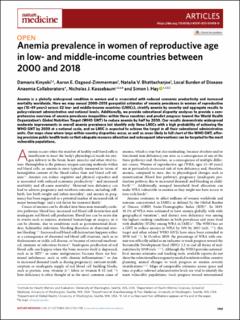| dc.contributor.author | Kinyoki, Damaris K. | |
| dc.contributor.author | Osgood-Zimmerman, Aaron E. | |
| dc.contributor.author | Bhattacharjee, Natalia V. | |
| dc.contributor.author | Kisa, Adnan | |
| dc.contributor.author | Kassebaum, Nicholas J. | |
| dc.contributor.author | Hay, Simon I. | |
| dc.contributor.author | Kisa, Sezer | |
| dc.contributor.author | Anaemia Collaborators, Local Burden of Disease | |
| dc.contributor.author | Zewdie, Dejene Tesfaye | |
| dc.contributor.author | Zhu, Congwen | |
| dc.contributor.author | Ziapour, Arash | |
| dc.date.accessioned | 2021-11-04T14:12:29Z | |
| dc.date.available | 2021-11-04T14:12:29Z | |
| dc.date.created | 2021-10-13T21:48:19Z | |
| dc.date.issued | 2021-10-12 | |
| dc.identifier.citation | Nature Medicine. 2021, . | en_US |
| dc.identifier.issn | 1078-8956 | |
| dc.identifier.issn | 1546-170X | |
| dc.identifier.uri | https://hdl.handle.net/11250/2827958 | |
| dc.description.abstract | Anemia is a globally widespread condition in women and is associated with reduced economic productivity and increased mortality worldwide. Here we map annual 2000–2018 geospatial estimates of anemia prevalence in women of reproductive age (15–49 years) across 82 low- and middle-income countries (LMICs), stratify anemia by severity and aggregate results to policy-relevant administrative and national levels. Additionally, we provide subnational disparity analyses to provide a comprehensive overview of anemia prevalence inequalities within these countries and predict progress toward the World Health Organization’s Global Nutrition Target (WHO GNT) to reduce anemia by half by 2030. Our results demonstrate widespread moderate improvements in overall anemia prevalence but identify only three LMICs with a high probability of achieving the WHO GNT by 2030 at a national scale, and no LMIC is expected to achieve the target in all their subnational administrative units. Our maps show where large within-country disparities occur, as well as areas likely to fall short of the WHO GNT, offering precision public health tools so that adequate resource allocation and subsequent interventions can be targeted to the most vulnerable populations. | en_US |
| dc.description.sponsorship | This study was funded by the Bill & Melinda Gates Foundation. | en_US |
| dc.language.iso | eng | en_US |
| dc.publisher | Nature Research | en_US |
| dc.relation.ispartofseries | Nature Medicine;27 (2021) | |
| dc.rights | Navngivelse 4.0 Internasjonal | * |
| dc.rights.uri | http://creativecommons.org/licenses/by/4.0/deed.no | * |
| dc.subject | Diseases | en_US |
| dc.subject | Risk factors | en_US |
| dc.title | Anemia prevalence in women of reproductive age in low- and middle-income countries between 2000 and 2018 | en_US |
| dc.type | Peer reviewed | en_US |
| dc.type | Journal article | en_US |
| dc.description.version | publishedVersion | en_US |
| dc.rights.holder | © The Author(s) 2021 | en_US |
| cristin.ispublished | true | |
| cristin.fulltext | original | |
| cristin.qualitycode | 2 | |
| dc.identifier.doi | https://doi.org/10.1038/s41591-021-01498-0 | |
| dc.identifier.cristin | 1945785 | |
| dc.source.journal | Nature Medicine | en_US |
| dc.source.volume | 27 | en_US |
| dc.source.pagenumber | 1761–1782 | en_US |

